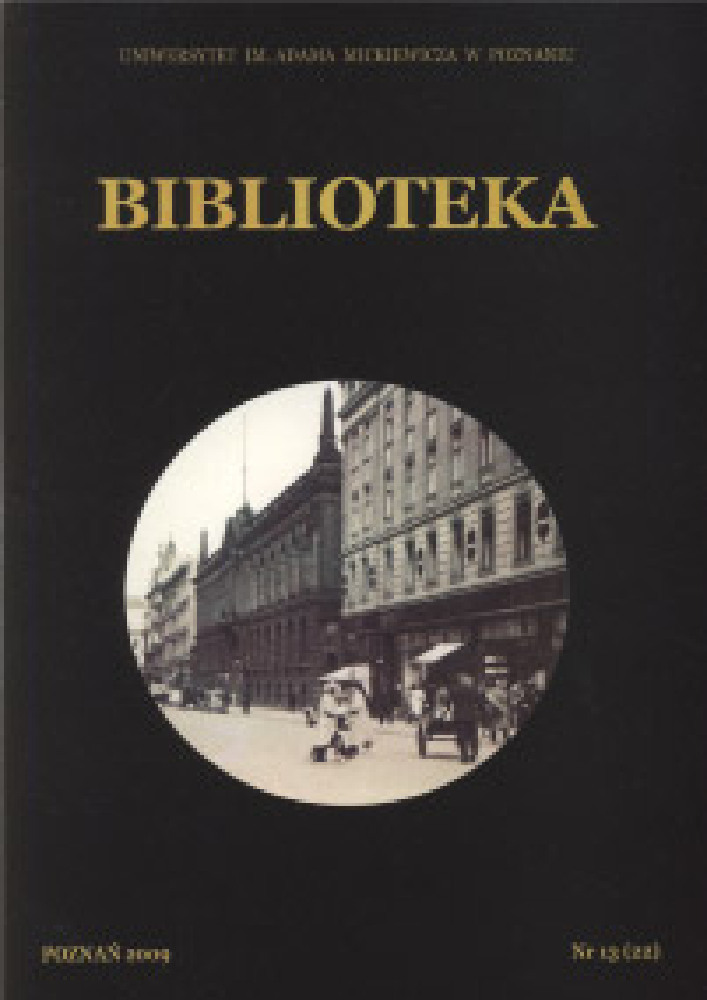Abstrakt
Poruszane w tekście zagadnienia wiążą się z problematyką budowy nowych systemów informacyjnych w nauce, które w piśmiennictwie określa się mianem e-library, library 2.0, e-science, Web 2.0 etc. Artykuł mówi o koniecznych zmianach zachowań ludzi nauki w zakresie publikowania w kontekście wspomnianych kierunków rozwoju komunikacji naukowej. Autor przewiduje, że budowa nowych systemów informacyjnych spopularyzuje samopublikację (self-publishing) tekstów naukowych, która zdynamizuje rozwój repozytoriów o otwartym dostępie (open access). Zjawisko samopublikacji wpłynie także na zmianę metod oceny publikacji naukowych. Ich ocena będzie mogła się dokonywać przez automatyczne obliczanie cytowalności. Stopniem uzyskiwanych cytowań będzie można także parametryzować teksty opublikowane przez autorów w repozytoriach już po pozytywnej ocenie peer review. Ponadto, jak twierdzi autor, zjawisko samopublikacji powinno spopularyzować blogosferę w nauce, a w tym kontekście z pewnością pojawi się nawyk bezpośredniego komentowania wzmianek uczonych o własnych pracach badawczych przez specjalistów reprezentujących te same dyscypliny. Taka wymiana informacji będzie możliwa dzięki rozpowszechnieniu się samopublikacji i powinna w pełni zastąpić organizowanie drogich konferencji naukowych, w których udział bierze najczęściej tylko część środowiska. Autor uważa, że na marginesie zasygnalizowanych zmian pojawią się także zjawiska niepożądane, których przejawem z pewnością będzie „wykluczenie” najstarszych generacji uczonych, z uwagi na niemożność opanowania przez nich nowych technologii.Bibliografia
Almind T.C., Ingwersen P., Informetric analyses on the world wide web: methodological approaches to ‘webometrics’, „Journal of Documentation” 1997, nr 53/4.
Cisek S., Nauka 2.0: nowe narzędzia komunikacji naukowej 2008 [on-line] [dostęp: 30.03.2009]. Dostępny w World Wide Web: http://eprints.rclis.org/12894/1/nauka_2.0.pdf.
Darnton R., „The Case for Open Access”. The Harvard Crimson. Online edition 2008 [on-line] [dostęp: 23.03.2009]. Dostępny w World Wide Web: http://www.thecrimson.com/article.aspx?ref=521835.
De Robbio A., Sequeiros P., Open archives for Library and Information Science: an international experience = Ogólnodostępne archiwa a informacja naukowa i biblioteczna – doświadczenia globalne, w: IV Ogólnopolska Konferencja EBIB: Internet w bibliotekach. Open Access,Toruń 2007 [on-line] [dostęp: 10.08.2008]. Dostępny w World Wide Web: http://en.scientificcommons.org/26098147.
Gienas K., Dozwolony użytek na rozdrożu 2005 [on-line] [dostęp: 31.03.2009]. Dostępny w World Wide Web: http://www.idg.pl/news/86793/Dozwolony.uzytek.na.rozdrozu.html.
Jeszke Ł., E-nauka i drogi jej rozwoju, „Język, Komunikacja, Informacja” 2008, nr 3.
Kowalski J., Z blogosfery do kariery, „iThink” 2008 [on-line] [dostęp: 6.03.2009]. Dostępny w World Wide Web: http://www.ithink.pl/artykuly/hyde-park/moim-zdaniem/nowe-oblicze-blogosfery/.
Lawrence S., Online or Invisible?, „Nature” 2001, nr 411 (6837), s. 521 [on-line] [dostęp: 24.06.2008]. Dostępny w World Wide Web: http://citeseer.ist.psu.edu/online-nature01/.
Nahotko M., Wpływ open access na poziom cytowań publikacji, w: IV ogólnopolska konferencja EBIB: Internet w bibliotekach. Open Access, Toruń, 7-8 grudnia 2007 [on-line][dostęp: 11.07.2008]. Dostępny w World Wide Web: http://www.ebib.info/publikacje/matkonf/mat18/nahotko.php.
Nowak P., Bibliometria. Webometria. Podstawy. Wybrane zastosowania, Poznań 2008.
Prensky M., Digital Natives, Digital Immigrants, „On the Horizon” 2001, t. 9, nr 5[on-line] [dostęp: 30.03.2009]. Dostępny w World Wide Web: http://www.marcprensky.com/writing/Prensky%20-%20Digital%20Natives,%20Digital%20Immigrants-%20%20Part1.pdf.
Rychlik M., Karwasińska E., Projekt powołania repozytorium Uniwersytetu im. Adama Mickiewicza w Poznaniu. Badanie ankietowe postaw pracowników naukowych, „Przegląd Biblioteczny” 2008, z. 3.
„Scientific Publication” (2005) Magazine on European Research. Special issue – November[on-line] [dostęp: 10.08.2008]. Dostępny w World Wide Web: http://ec.europa.eu/research/rtdinfo/special_comm/02/images/sp_comm_dos1_art01_01_4401_en.jpg.
„State of the Blogosphere” (2008) Technorati [on-line] [dostęp: 6.04.2009]. Dostępny w World Wide Web: http://www.technorati.com/blogging/state-of-the-blogosphere/.
Sulston J., Stiglitz J., Science is being held back by outdated laws. The question „who owns science?” is now crucial, „The Times” 2008 [on-line] [dostęp: 23.03.2009]. Dostępny w World Wide Web: http://www.timesonline.co.uk/tol/comment/letters/article4271555.ece.
Swan A., Brown S., Open access self-archiving: An author study 2005 [Departmental Technical Report] [on-line] [dostęp: 9.04.2009]. Dostępny w World Wide Web: http://cogprints.org/4385/.
Wróblewski A.K., Bibliometryczna trylogia 2001 [on-line] [dostęp: 9.04.2009]. Dostępny w World Wide Web: http://www1.bg.us.edu.pl/Publikacje/Cieszyn/wroblewski.pdfajetan.
Licencja
Prawa autorskie (c) 2009 Piotr Nowak

Utwór dostępny jest na licencji Creative Commons Uznanie autorstwa – Na tych samych warunkach 4.0 Miedzynarodowe.
Utwory opublikowane w czasopiśmie Biblioteka, na platformie Pressto należącej do Uniwersytetu im. Adama Mickiewicza w Poznaniu od 2015 roku są udostępniane na
licencji Creative Commons Uznanie autorstwa-Na tych samych warunkach 4.0 Międzynarodowe.
Tym samym wszyscy zainteresowani są uprawnieni do korzystania z utworów opublikowanych po 2015 roku pod następującymi warunkami:
- uznania autorstwa czyli obowiązek podania wraz z rozpowszechnianym utworem informacji o autorstwie, tytule, źródle (odnośniki do oryginalnego utworu, doi) oraz samej licencji
- na tych samych warunkach — remiksując utwór, przetwarzając go lub tworząc na jego podstawie, należy swoje dzieło rozpowszechniać na tej samej licencji, co oryginał.
Uniwersytet im. Adama Mickiewicza w Poznaniu zachowuje prawo do czasopisma jako całości (układ, forma graficzna, tytuł, projekt okładki, logo itp.).
Autor zachowuje prawa majątkowe, ale udziela zgody Uniwersytetowi im. Adama Mickiewicza w Poznaniu na wykorzystanie dzieła. Autorzy tekstów zakwalifikowanych do publikacji proszeni są o wypełnienie podpisanie i przesłanie umowy.
Jeżeli autor artykułu nie jest przekonany, że może wykorzystywać cudze utwory (np. ilustracje, fotografie, tabele) w ramach cytatu we własnej tekście musi dostarczyć do redakcji czasopisma zgodę od uprawnionych podmiotów.
Prawa są zastrzeżone do wszystkich tekstów opublikowanych przed rokiem 2015.





